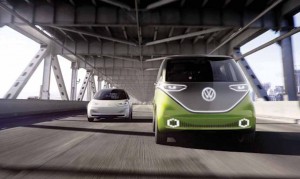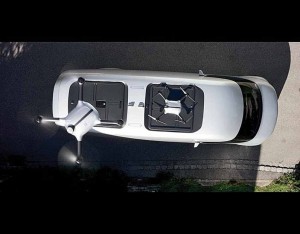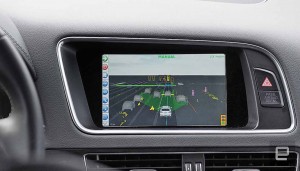CV technologies at CES 2017 reflected on the future of autonomous and automated driving.
Story by: Ashish Bhatia
Held at Las Vegas, US, the CES 2017 fair saw the display of commercial vehicle technologies that will further the case of automonous and automated driving. The 2017 edition, held between January 05 and January 08, 2017, brought to the fore the latest in technologies. Technologies that will set the tone for the future. As a launchpad for new innovation and technology, the CV technologies that shone at the show were the Mercedes-Benz ‘Vision Van’, Volkswagen ‘I.D. Electric Concept’, and Honda ‘New Electric Urban Vehicle (NEUV)’.
The NEUV from Honda is an urban electric vehicle designed for ‘ride sharing’ with enough storage space at the rear. Capable of moving people, and cargo, the NEUV, according to Honda is an automated electric commuter vehicle equipped with Artificial Intelligence (AI) powered ‘emotion engine’. The ‘emotion engine’ of the NEUV was developed by Cocoro SB, a Japanese AI specialist. Said to be capable of judging the emotions of the driver, and accordingly changing the ‘behaviour’, the ‘emotion engine’ also takes into account the driver’s past decisions to recommend new choices. The process is called as Automated Network Assistant (ANA). The incorporation of AI in NEUV, claimed a Honda source, helped the company to harness the power of artificial intelligence, robotics and big data. It also helped them to create new possibilities for human interaction with an electric car. Exploring the idea of how to create new value for its owner by functioning as an automated ride-sharing vehicle, picking up and dropping off commuters at local destinations, even in the absence of the owner, the NEUV has a touch panel, which the driver and passenger can use. There’s an electric skateboard for ‘last mile’ transit. The header-less windshield improves visibility.
At CES 2017, Volkswagen spoke about an I.D. electric microbus concept that builds upon the concept of a highly automated electric car shown at the 2016 Paris Motor Show. The microbus concept can cover a distance of 400 to 600 kms on a single charge. Combining digitally connected world with an electric drive, the concept highlights the idea of an unique identity. Whoever drives the vehicle gets a Volkswagen identity. Therefore the name I.D. The identity is an individual profile, which enables the owner to save his or her personal seat and air conditioning settings, favourite radio stations and songs, sound system settings, exterior sounds, configuration of the navigation system, and type of ambient lighting. It can also save the contact details of the driver’s friends and business associates. This profile is then available for secure access via the cloud, enabling the I.D. to recognise the legitimate user by their smartphone, using a digital key. As of current, the I.D. Electric microbus has a car for company. Both are based on what the Volkswagen engineers term as an all-new Modular Electric Drive (MEB) platform. Expected to go into production by 2020, the electric microbus, designed to connect with the legendary Transporter Kombi, accelerates from 0 to 60 mph in 5 seconds. An all-wheel drive, the concept can fast charge up to 150 kW.
The Mercedes Benz ‘Vision van’ comes with a fully automated cargo loading system. Automated racks organise the packages for the driver. The system loads all parcels at the same time and organises them to show the deliverer the exact load configuration. It ensures that the right package is made available, and at the right time this depends on the delivery destination. Heightening the futuristic appeal are the two drones atop the van. While human intervention is needed to drop-off something at the doorstep conventionally, the drones in the latter are said to be capable of delivering packages, weighing up to four pounds within a six-mile radius, and at speeds of up to 60 kmph. Their flying height range is between 50 m and 200 m. The van concept features telematics unit that collects and processes data concerning the delivery status. The data is sent to the distribution manager, increasing accuracy. Such systems, according to Daimler sources, allow drivers to deliver multiple packages at once, increasing efficiency in an urban environment especially. The van is equipped with a 75 kW electric drive. Depending on the intended application, it can travel between 80 and 270 km on a single charge. Designed with an aim to boost the efficiency of delivery by up to 50 per cent, the ‘Vision Van’ is part of a five-year, Euro 500 million revamp of Mercedes-Benz’s commercial vehicle division. Going forward, the new feature set is said to hold the capability of being scaled up to public transit, such that it makes public transit. Capable of paving way for individual transport of passengers on similar lines during peak and off-peak hours via modern day ride-sharing concepts, the ‘vision van’ is truly a reflection of the future.
Automotive suppliers at CES 2017
American technology company Nvidia and automotive supplier ZF Friedrichshafen AG launched a new, self-driving vehicle system designed for commercial applications. The ZF ProAI system is claimed to make commercial vehicles involved in factory work and agriculture autonomous. According to Nvidia Automotive Vice President, Rob Csongr, ‘artificial intelligence’ is a technology that will spark an industrial revolution. Not just trucks, but the ProAI system is expected to benefit commercial vehicles like forklifts and ‘material-handling vehicles’. “The benefits of Artificial Intelligence (AI) powered vehicles are a drop in traffic congestion and fatalities,”he added. At CES 2017, tier suppliers Delphi, Valeo, and Autoliv demonstrated incremental improvements in areas like sensors and software. Delphi showcased a new multilayer graphics display, which is the result of Delphi’s acquisition of New Zealand-based Pure Depth. The technology is expected to go into series production in 2019. With its partner DigiLens, Continental showcased a ‘head-up display’, which projects over a larger area of the windshield than the current crop of projectors are capable of. German transportation technology company IAV Automotive Engineering showcased automated driving technology that is aimed at reducing urban traffic jams and the associated pollution. Esri’s Enterprise GIS platform services on Azure Cloud provide geographic and analytical content that better understands driver behavior, predicts road conditions to improve traffic flow, and shares data from vehicle sensors connected to the ecosystem. These features are claimed to allow ‘smart cities’ to react swiftly to issues like unsafe bumps or dangerous objects on the road. Swiss Re simulated customised insurance coverage using Microsoft’s Azure technology to deliver future connected mobility solutions.































